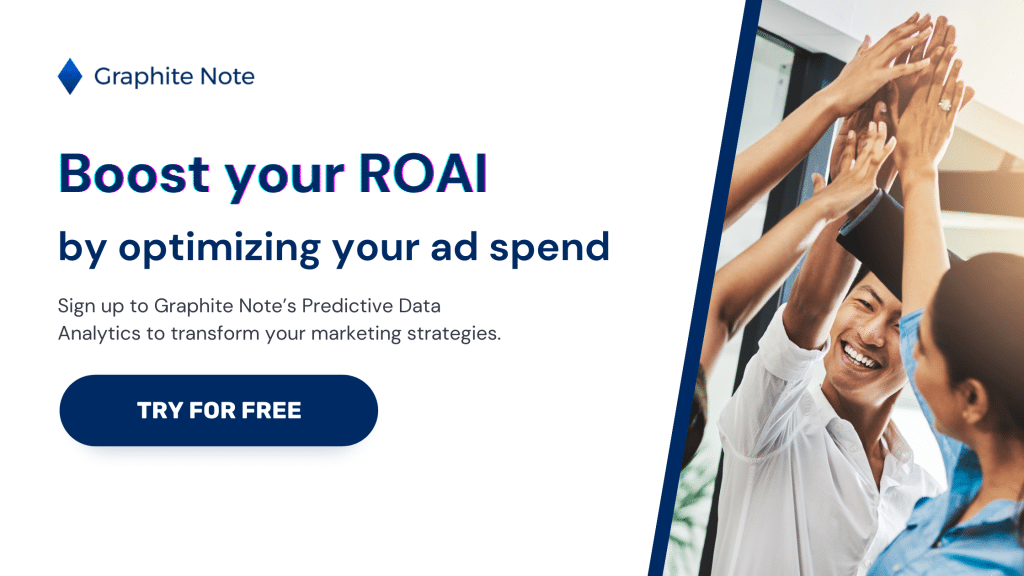It’s important to optimize your advertising campaigns and ensure maximum efficiency. Predictive analytics can help. Predictive analytics enables you to make informed decisions. Predictive analytics tools help you improve targeting strategies, and drive better results. We outline the world of predictive analytics. We explore how the predictive analytics process can help you maximize the efficiency of your ad campaigns.
Understanding Predictive Analytics
We help you understand what predictive analytics entails. Predictive analytics uses historical data to make predictions about future outcomes. Predictive analytics analyzes patterns, trends, and correlations within your business data. Predictive analytics algorithms can generate insights that provide valuable guidance for decision-making. There are several types of predictive analytics techniques.
Regression analysis involves examining the relationship between variables to predict future outcomes. Classification is where data is categorized into different groups based on certain attributes. Clustering algorithms identify patterns and group similar data points together. Predictive analytics examples extend across various industries and sectors. Data analytics can be applied to improve and enhance business performance in many ways. Popular predictive analytics models and platforms are now almost commonplace in marketing and advertising.
The Basics of Predictive Analytics
With user-friendly platforms like Graphite Note, your business can benefit from predictive analytics. You don’t need extensive technical knowledge. Graphite Note empowers marketers to use sophisticated analytics capabilities. A simple drag-and-drop interface makes it accessible to beginners and seasoned professionals alike. Intuitive features and customizable templates make it easy to import your business data. Graphite Note helps you select the desired predictive models. You can generate actionable insights in a matter of minutes. Graphite Note offers a wide range of built-in algorithms and statistical functions. You’re free to explore and experiment with different approaches to predictive analytics. From linear regression to decision trees, Graphite Note is a comprehensive toolkit. Graphite Note can be used across your business, to solve various business problems using prescriptive analytics and predictive analytics.
The Role of Predictive Analytics in Advertising
Predictive modeling identifies patterns and trends in consumer behavior. Predictive analytics can provide valuable insights into target audience preferences. Using this information, marketers can tailor their campaigns accordingly. Predictive analytics analyzes historical data on customer demographics, purchasing behavior, and online interactions. Your machine learning model can then help identify the most profitable customer segments. This ensures you allocate your advertising spend to the most relevant audience segments. This increases the efficiency and effectiveness of your campaigns. Using predictive analytics in marketing is one of the easily understood predictive analytics examples.
Predictive analytics can also assist in optimizing ad placement and timing. Predictive analytics can analyze past campaign performance and external factors. Marketers can determine the best channels and time slots to reach their target audience. This proactive approach maximizes the chances of delivering the right message to the right people at the right time. In turn, your business benefits from higher engagement and conversion rates.
Predictive analytics can also play a role in customer retention and loyalty. Business analytics tools can identify early warning signs of customer churn. These may be a decrease in engagement or a shift in purchasing behavior. Armed with this information, marketers can take proactive measures to keep valuable customers. Big data analytics can help you stay one step ahead and foster long-term customer relationships.Predictive analytics is a powerful tool that enables you to optimize your advertising efforts. Marketers can gain valuable insights into consumer behavior. Marketers can better tailor their campaigns to specific audience segments. In the end, your marketing team can achieve better results. User-friendly platforms like Graphite Note enable anyone to benefit from predictive analytics.
The Intersection of Ad Campaigns and Predictive Analytics
Predictive modeling techniques and ad campaigns go hand in hand. Incorporate predictive analytics into your advertising strategy and you can reap several benefits.
How Predictive Analytics Enhances Ad Campaigns
Predictive analytics enables you to create highly personalized and targeted ad campaigns. These campaigns resonate with your audience on a deeper level. You can deliver tailored messages and offers that are more likely to convert. This level of personalization enhances user experience. Similarly, predictive analytics increases your ability to achieve your campaign goals.
Predictive analytics analyzes customer data to identify specific trends and preferences. This level of customization boosts your conversion rates and drives higher revenue.
Predictive analytics can also help you optimize the timing and placement of your ads. You can identify the most effective times and platforms to reach your target audience. This helps you schedule and plan your advertising campaigns more effectively.
Predictive Analytics and Ad Efficiency
Predictive analytics helps with maximizing the efficiency of your ad campaigns. You can identify underperforming campaigns or channels in real-time. You can make data-driven decisions to allocate your budget. This saves you time and money and ensures that your resources are being used in the most effective manner. That leads to higher returns on investment (ROI).
With predictive analytics, you can continuously monitor the performance of each campaign. You can easily identify any that are not meeting your desired objectives. You can identify underperforming campaigns in real time. You can reallocate your budget to the ones that are generating the highest ROI. Predictive analytics helps you maximize the efficiency of your advertising efforts.
Predictive analytics can also help you optimize your ad targeting. Analyzing customer data and behavior, you can identify the most relevant audience segments. This enables you to focus your ad spend on those who are most likely to convert. You’ll minimize wasted impressions and increase the efficiency of your campaigns.
Steps to Incorporate Predictive Analytics into Your Ad Campaign
Identify Your Advertising Goals
It is essential to clearly define your advertising goals. Are you looking to increase brand awareness? Drive website traffic? Generate leads? Consider the current state of your business and industry. Are you a new startup looking to establish a presence in the market? Or are you an established company looking to expand your customer base? Take these factors into account. You can set realistic and achievable goals that align with your business strategy.
Conduct market research and analyze consumer behavior. This gives you a deeper understanding of your target audience. Segment your audience based on demographics, interests, and purchasing behavior. You can create more personalized, targeted ad campaigns that resonate with your customers.
Choosing the Right Predictive Analytics Solutions
It’s important to consider the features your predictive analytics platforms include. Predictive analytics capabilities are key for ensuring successful implementation for your business. Look for platforms that have robust data collection capabilities. These enable you to gather and analyze large volumes of data from various sources. The ability to handle structured and unstructured data is also important. This allows you to extract valuable insights from a wide range of data types. Your predictive analytics platform should offer a comprehensive set of machine learning algorithms. Machine learning algorithms are the backbone of predictive analytics. Data science helps you build accurate models and make accurate predictions. Look for platforms that provide a diverse selection of algorithms.
Machine learning models include regression models, classification, time series models, clustering, and time series analysis. Your predictive analytics platform should have an intuitive interface. Look for easy-to-use dashboards for data visualization. You need to be able to visualize your data to better understand and communicate about them. Consider platforms that offer intuitive and customizable dashboards. These enable you to create interactive visualizations that can be shared with stakeholders.
Integration of predictive analytics capabilities with existing systems and software are also important. The platform should be able to seamlessly integrate with your current infrastructure. Direct integration connects you to your existing data sources and workflows. A good predictive analytics platform offers you robust APIs and connectors. A predictive analytics tool must integrate with popular tools and technologies.
Implementing Predictive Analytics in Your Campaign Strategy
There are several steps to implementing predictive analytics as part of your ad campaign strategy:
- Data collection: During data collection, you gather relevant data to feed to your predictive analytics solution. Predictive analytics solutions then store that data. Your data sets could take on the form of structured data, like your internal databases. You can also use unstructured data for your predictive analytics tools. Unstructured data could be sourced from social media, web logs, and other sources. Collectrelevant data points from various sources. These include your website analytics, social media platforms, and customer databases. You need diverse and comprehensive data sets. These improve the predictions from your predictive analysis software. When collecting data, it’s important to ensure its quality and accuracy. Clean and reliable data enables accurate predictive modeling and analysis.
- Data preprocessing and data cleaning: Next, your data is preprocessed and cleaned to ensure it is accurate and consistent. Your predictive analysis tools remove any outliers or errors. Your predictive analytics platform handles missing values. Your predictive analytics tool transforms the data into a suitable format for analysis. Data preprocessing is an important step in predictive analytics. The quality of the input data directly affects the accuracy of the predictions you get from your data science platform.
- Model implementation: At this point, advanced analytics steps in. Statistical models and machine learning algorithms uncover patterns and make predictions. These models can range from simple linear regression to more complex algorithms. Complex algorithms include time series, classification models, decision trees, neural networks, and support vector machines. The choice of model depends on the nature of the data and the business problem you’re trying to solve. Explore different predictive analytics models, algorithms, and techniques to uncover patterns, correlations, and trends.
- Get your insights: The insights produced by the predictive models are presented in a meaningful and actionable way. Predictive tools give you data visualization facilities. Your predictive tools should have dashboards, report functions, and other data presentation formats. This helps you explore the predictions and understand the underlying factors driving them. Using these insights, you can optimize your ad campaign strategies, target the right audience, and allocate your advertising budget.
- Monitoring and evaluation: The predictive analytics process is iterative. Monitor and evaluate the performance of your ad campaigns. Refine your predictive models accordingly. Analyzing and updating your data, so you can adapt to changing market dynamics. This ensures the long-term success of your advertising efforts.
Measuring the Success of Your Predictive Analytics-Driven Campaign
You must be able to measure the success of your predictive analytics-driven campaign.
Key Performance Indicators for Ad Campaigns
Key performance indicators (KPIs) play an important role. Tracking important metrics to measure your campaign success. Metrics include your conversion rate, click-through rate, cost per acquisition, and return on ad spend. You can assess the effect of your predictive analytics-driven campaign. As you continue, you can make necessary adjustments to further optimize your campaigns.
Interpreting Predictive Analytics Data
Interpreting the data generated by your predictive analytics tool is key to making informed decisions. Graphite Note simplifies this process. Graphite Note gives you intuitive visualizations and easy-to-understand reports. You can easily extract valuable insights without the need for specialized data analysis skills. Analyze the data and identify the patterns, so you can iterate on your campaigns, ensuring ongoing success and efficiency.

Future Trends in Predictive Analytics and Advertising
The Evolution of Predictive Analytics in Advertising
We can expect predictive analytics to become even more sophisticated and refined in the realm of advertising. Machine learning algorithms continue to improve, and marketers will gain access to real-time data and dynamic insights. This will enable even more precise targeting and personalized messaging. Advancements in artificial intelligence (AI) will open up new avenues for automation and optimization.
Predictive Analytics and the Future of Ad Campaign Efficiency
More and marketers have begun to incorporate predictive analytics into their strategies. This leads to increased ROI, improved targeting, and enhanced customer experiences. Using tools like Graphite Note, predictive analytics helps you improve your ad campaigns.
Predictive analytics can revolutionize the way you approach your advertising campaigns. Through platforms like Graphite Note, you can reap the benefits of predictive analytics.




